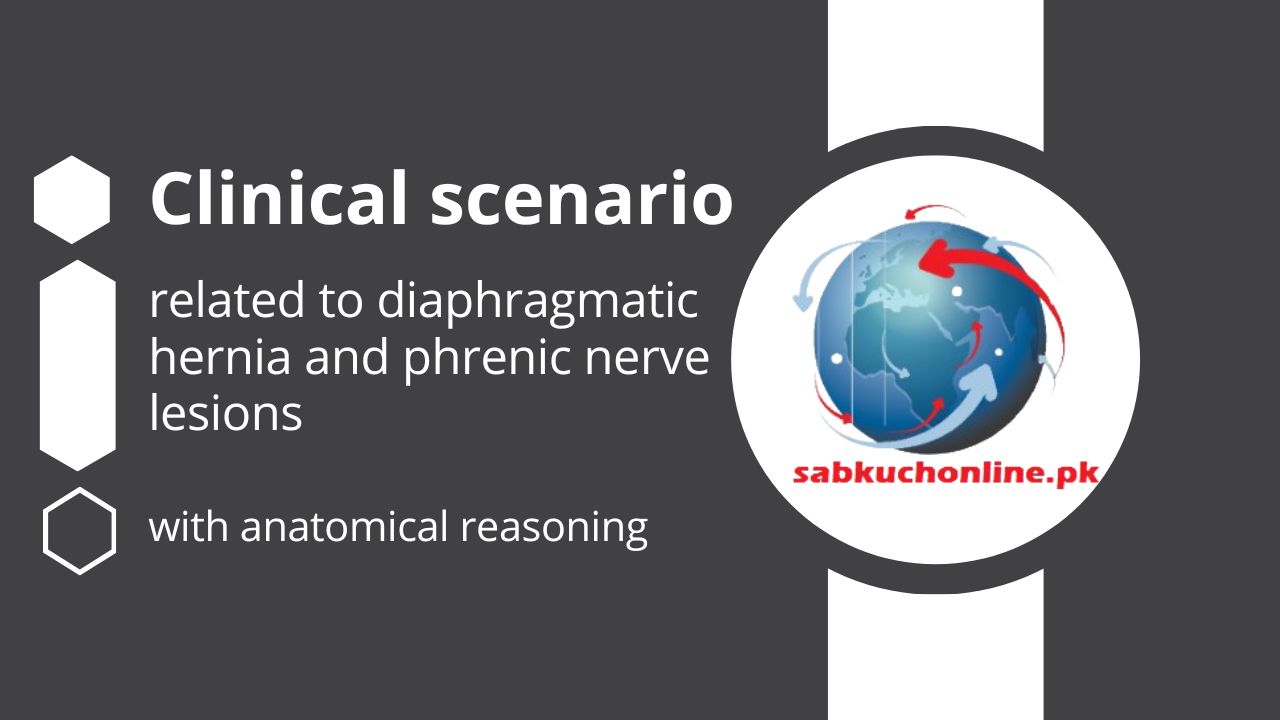Clinical Scenario: Diaphragmatic Hernia
Scenario:
A newborn presents with respiratory distress and abdominal distension. Upon examination, decreased breath sounds are noted on one side of the chest. Chest X-rays reveal abdominal organs in the thoracic cavity.
Anatomical Reasoning:
This clinical scenario is indicative of a congenital diaphragmatic hernia (CDH), where there is an abnormal opening or weakness in the diaphragm, allowing abdominal organs to herniate into the thoracic cavity. The diaphragmatic hernia compromises the separation between the thoracic and abdominal cavities.
- Anatomical Basis:
- Embryonic Development:
- During embryonic development, the diaphragm forms from various structures, including the septum transversum, pleuroperitoneal membranes, and muscular ingrowths.
- Defective Closure:
- Anomalies in the closure of these structures can lead to diaphragmatic hernias.
- Herniation of Organs:
- The weakened or incompletely formed diaphragm allows abdominal organs, such as the intestines and liver, to herniate into the thoracic cavity.
- Impaired Lung Development:
- The presence of abdominal organs in the thoracic cavity compromises lung development, resulting in respiratory distress.
- Embryonic Development:
- Clinical Implications:
- Respiratory Distress:
- Herniation of abdominal organs can compress the lungs and interfere with their expansion.
- This leads to respiratory distress in the newborn, which is a hallmark of CDH.
- Respiratory Distress:
- Diagnostic Imaging:
- Chest X-rays:
- Imaging studies, such as chest X-rays, reveal the displacement of abdominal organs into the thoracic cavity.
- The characteristic finding is a “scimitar sign” or “opposite heart sign,” indicating the presence of abdominal contents in the chest.
- Chest X-rays:
Clinical Scenario: Phrenic Nerve Lesions
Scenario:
A patient presents with unilateral diaphragmatic paralysis and complains of difficulty breathing. There is a noticeable asymmetry in chest movement, with decreased expansion on one side during inspiration.
Anatomical Reasoning:
The clinical scenario is consistent with a lesion or injury to the phrenic nerve, the primary nerve supplying the diaphragm.
- Anatomical Basis:
- Phrenic Nerve Origin:
- The phrenic nerve arises from the cervical nerves C3, C4, and C5.
- It descends through the neck and enters the thoracic cavity, providing motor and sensory innervation to the diaphragm.
- Unilateral Lesion:
- A lesion or injury to one phrenic nerve can result in unilateral diaphragmatic paralysis.
- Phrenic Nerve Origin:
- Clinical Implications:
- Breathing Difficulty:
- The affected side of the diaphragm becomes paralyzed or weakened, leading to difficulty in generating adequate negative intrathoracic pressure during inspiration.
- Asymmetry in Chest Movement:
- During inspiration, the normal side descends, while the paralyzed side moves minimally or paradoxically.
- This results in asymmetrical chest movement.
- Breathing Difficulty:
- Diagnosis and Assessment:
- Physical Examination:
- The clinical presentation includes reduced chest expansion on the affected side.
- Imaging Studies:
- Radiological studies, such as fluoroscopy or ultrasound, may be used to visualize diaphragmatic movement.
- Physical Examination:
Integration of Anatomical Knowledge:
Understanding the anatomical basis of diaphragmatic hernias and phrenic nerve lesions is essential for accurate clinical diagnosis and management. In both scenarios, anatomical reasoning allows healthcare professionals to connect the observed clinical findings with the underlying structural or neurological abnormalities, guiding appropriate interventions and treatment strategies.
